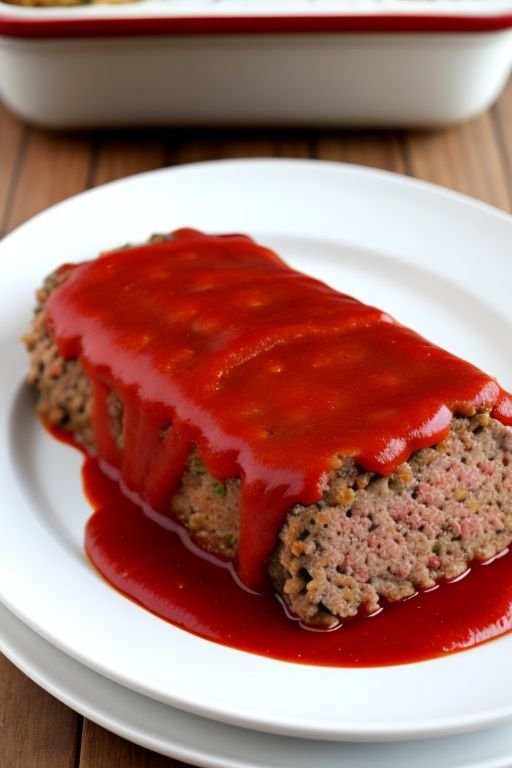What does meatloaf mean? In this comprehensive exploration of meatloaf, we’ll dive into everything from its humble beginnings to its place at the dinner table and beyond. This beloved dish is more than just ground meat in loaf form; it’s a cultural icon, a dietary staple, and a subject of culinary creativity. So, let’s cut into the heart of what makes meatloaf a fascinating topic not only for food enthusiasts but also for anyone curious about its rich history and versatile nature.
Understanding What does meatloaf mean?
The Definition and Origins of Meatloaf
When you think of meatloaf, what springs to mind? Perhaps it’s the quintessential family dinner. Or maybe it’s an image of a hearty, comforting meal that grandma used to make. Indeed, both impressions are correct. Yet, there’s much more to this dish than meets the eye.
Early History and Evolution
Meatloaf originated from a blend of finely chopped or ground meat mixed with ingredients like breadcrumbs, spices, and onions. Its earliest documentation dates back to 5th-century Rome. At that time, it was a clever method to stretch less meat into more meals. Over the centuries, this dish has traveled across continents. It adapted to local tastes and ingredients, making it a global staple with a local twist in many regions.
Modern Adaptations and Global Reach
Today, meatloaf stands as a testament to culinary ingenuity and simplicity. It is a dish that can be whipped up with pantry staples. Yet, it can be tweaked to gourmet levels with just a few creative adjustments. Moreover, it’s a canvas for flavors, capable of incorporating various spices and ingredients. From the traditional ketchup topping to glazes that might include brown sugar or even mustard, these additions create a melange of tastes that tickle the palate.
Meatloaf in American Culture
In the United States, meatloaf gained particular popularity in the 20th century during economic hardships, such as the Great Depression. Its cost-effectiveness and flexibility made it ideal. It’s a dish that tells a story of survival and adaptation through its various iterations. From the classic meatloaf to more modern versions that might include turkey or vegan alternatives.
Cultural Significance and Variations
But beyond its practicality and taste, meatloaf has woven itself into the cultural fabric of societies. It’s a symbol of home, of comfort, and of the blending of traditions and innovations. From the smoky, glazed versions enjoyed in parts of Scandinavia to the ketchup-slathered slices found in American diners, each variation of meatloaf holds a mirror to the customs and tastes of its people.
So next time you sit down to a delicious slice of meatloaf, remember that you’re not just eating a meal. You’re partaking in a rich historical journey that spans continents and centuries. A journey that continues to evolve, making meatloaf as relevant today as it was hundreds of years ago. As we move forward in this article, we’ll delve deeper into the variations of meatloaf and how this dish adapts across different cultures, proving its enduring appeal. Stay tuned for a savory slice of history in the next section!
What does meatloaf mean? in Modern Cuisine
Variations and Popular Recipes
Meatloaf, beloved and versatile, has transformed globally. It evolved from a simple mix of ground meat and spices into diverse recipes.
Adaptable for Any Diet
One delightful aspect of meatloaf is its adaptability. Whether seeking a low-carb option or a plant-based alternative, you can find a suitable recipe. For instance, gluten-free meatloaf substitutes traditional breadcrumbs with rolled oats or almond flour. This makes it suitable for those with dietary restrictions.
Healthier Options
Turkey meatloaf has grown in popularity as a healthier choice. It reduces fat but retains the moist, flavorful experience. Ingredients like minced garlic, chopped onions, and herbs enhance its taste.
The Classic Meatloaf
Then there’s the classic meatloaf, often recalled from childhood dinners. It combines ground beef, breadcrumbs, eggs, and a tangy ketchup glaze. This version remains a staple, providing comfort and satisfaction.
Gourmet Innovations
Beyond the traditional, chefs and home cooks have created gourmet versions. Some meatloaves include spinach and goat cheese, or are wrapped in bacon for extra flavor. These versions enhance both taste and presentation.
International Variations
Internationally, meatloaf appears in various forms. In Germany, Hackbraten may include chopped pickles and mustard, adding a tangy twist. In Sweden, it’s often served with creamy brown sauce and lingonberry jam. These adaptations show how different cultures tailor the dish to fit traditional flavors.
Meatloaf: A Global Phenomenon
As we explore these variations, meatloaf emerges not just as a dish, but as a global phenomenon. It adapts to the tastes of each generation and region. It provides comfort and a sense of home-cooked meals.
Whether you love meat or prefer plant-based dishes, there is a meatloaf recipe for you. This dish continues to be loved worldwide, blending culinary traditions and innovations.
Explore the historical journey of meatloaf and understand how it became a global favorite. Stay tuned as we delve deeper into its symbolic meanings in our next section. Meatloaf is more than food—it’s a slice of cultural history.
Meatloaf Beyond the Plate
What does meatloaf mean? in Media
Cultural Symbolism
- Meatloaf reflects societal values, economic conditions, and family traditions.
- It transcends its role as mere sustenance.
Media Portrayals
- Frequently featured in movies and TV.
- Symbolizes middle-class American life and familial bonding.
- Evokes warmth and nostalgia.
Literary Significance
- Often appears in literature as the center of family gatherings.
- Acts as a catalyst for conversation and conflict resolution.
- Represents home, heritage, and comfort.
Economic Resilience
- Symbolizes affordability and resourcefulness during tough economic times.
- Celebrated for its practicality during the Great Depression and recessions.
Societal Shifts
- Meatloaf recipes have evolved from basic to elaborate or health-conscious.
- Reflects changing nutritional trends and societal attitudes towards food.
- Mirrors the shift towards sustainable eating practices.
Modern Adaptations
- Continues to adapt to modern tastes and dietary needs.
- Its media representation evolves, reflecting gastronomic trends.
- Each slice tells a story of cultural adaptation and change.
As we continue to explore the rich cultural tapestry meatloaf represents, its impact extends beyond the kitchen. Stay tuned for further insights into the nutritional aspects of meatloaf and its place in contemporary diets.
Analyzing Meatloaf’s Nutritional Content
Health Benefits and Concerns of Meatloaf
Nutritional Impact
Meatloaf, a comfort food, varies in nutrition based on its ingredients. It can be both nourishing and indulgent.
Protein Content
- At its core, meatloaf consists of ground meat like beef, pork, or turkey.
- This makes it a robust source of protein, essential for muscle repair and growth.
Fat Content Variations
- The type of meat affects the fat content.
- Using ground turkey or chicken can reduce fat levels, offering a leaner option.
Vegetable Additions
- Including vegetables like onions, peppers, and carrots boosts flavor and nutrition.
- These additions enhance the dish with vitamins, minerals, and fiber.
Alternative Binders
- Traditional meatloaf uses breadcrumbs for binding and adding carbs.
- Alternatives like almond flour or rolled oats can reduce gluten and carbs, and increase fiber.
Glaze and Toppings
- Typical toppings include ketchup or barbecue sauce, often high in added sugars.
- Healthier options might involve a homemade glaze with less sugar, or spices and herbs.
Balanced Meals
- Serving meatloaf with sides like steamed vegetables or salad ensures a well-rounded meal.
- This combination provides various nutrients, supporting a balanced diet.
Moderation and Adjustments
- Meatloaf should be consumed in moderation due to potential high fat and cholesterol.
- Adjusting ingredients for leaner meats and healthier options can make it more diet-friendly.
Common Questions About Meatloaf
Answers to Popular Queries
What does meatloaf mean? with its rich history and countless variations, naturally raises many questions among both seasoned cooks and those new to the kitchen. Here, we address some of the most common inquiries related to preparing, serving, and reinventing this classic dish.
What can I substitute for breadcrumbs in meatloaf to make it gluten-free?
A: To make meatloaf gluten-free, consider using rolled oats, crushed gluten-free crackers, or even cooked quinoa as binders. These substitutes not only keep the loaf together but also add a nutritional boost.
How can I keep my meatloaf from falling apart?
A: Ensuring your meatloaf doesn’t crumble is all about the right mix of ingredients. Besides the binder (like breadcrumbs or its substitutes), adding eggs can help. The eggs act as a glue, holding the meat and other components together. Make sure not to overmix as it can make the meatloaf tough and more likely to fall apart.
Is meatloaf considered a healthy meal?
A: Meatloaf can be part of a healthy diet when prepared with lean meats like turkey or chicken and packed with vegetables for added fiber and nutrients. Watching the additions such as the type of binder and toppings can also influence its healthiness.
Can meatloaf be made ahead of time and frozen?
A: Absolutely, meatloaf is a great dish to prepare ahead of time. You can either freeze it raw or fully cooked. If frozen raw, prepare the loaf as usual, wrap it tightly to avoid freezer burn, and freeze. Thaw in the refrigerator overnight before baking. If freezing after cooking, slice it once cooled, then freeze in portions for easy reheating.
What are some creative ways to use leftover meatloaf?
A: Leftover meatloaf offers a range of possibilities. It can be sliced and made into hearty sandwiches, crumbled into pasta sauces, or even diced into savory meatloaf hash for breakfast. Each option gives a delicious new life to your leftovers.
Is meatloaf gluten-free?
A: Traditional meatloaf recipes include breadcrumbs, which contain gluten. However, by substituting with gluten-free breadcrumbs or another alternative mentioned earlier, you can easily make a gluten-free meatloaf.
What sides pair well with meatloaf?
Meatloaf pairs wonderfully with a variety of sides. For a healthier meal, opt for steamed vegetables, a vibrant salad, or mashed sweet potatoes. For something heartier, classic options like mashed potatoes, green bean casserole, or mac and cheese are perfect.
These FAQs not only enhance your understanding What does meatloaf mean? but also equip you with tips to customize this dish to your taste and dietary needs. As we continue to explore this beloved dish, our next section will delve into optimizing meatloaf content for those interested in sharing their culinary creations online. Stay tuned for tips on using SEO and keyword strategies to boost your food blogging or culinary website.
The Future of Meatloaf
Evolving Trends and Innovations
As we look towards the future, meatloaf continues to adapt and evolve, reflecting changes in culinary tastes, dietary preferences, and technological advancements. Here, we explore how this timeless dish is being reinvented for a new generation and what trends might shape its trajectory in the culinary world.
Plant-Based Innovations
With the rise of plant-based diets, chefs and home cooks alike are experimenting with vegetarian and vegan versions of meatloaf. Ingredients like lentils, chickpeas, and textured vegetable protein are being used to mimic the texture and flavor of traditional meatloaf. These innovations not only cater to dietary restrictions but also align with a growing emphasis on sustainability and ethical eating.
Health-Conscious Recipes
As health awareness increases, so does the demand for meals that are both nutritious and delicious. Future meatloaf recipes might lean more towards using superfoods like quinoa and chia seeds, which offer enhanced nutritional profiles including omega-3 fatty acids and antioxidants. Additionally, the integration of more vegetables and lean meats will likely continue to be a trend, making meatloaf a healthier option for family dinners.
Culinary Technology and Meatloaf
The use of technology in cooking methods could also influence how meatloaf is prepared. Techniques like sous-vide, which involves cooking food in a vacuum-sealed bag in a water bath at a precisely controlled temperature, could ensure that meatloaf is cooked to perfection every time, enhancing flavors and textures that traditional oven baking might not achieve.
Global Flavors
Globalization has introduced a variety of flavors and spices from around the world into everyday cooking. Future meatloaf recipes could incorporate flavors from different cuisines, such as using Gochujang (Korean chili paste) for a spicy kick or blending in Moroccan spices for an exotic touch. This fusion approach could redefine meatloaf as a global dish that transcends cultural boundaries.
Interactive and Personalized Cooking Experiences
With the growth of digital media and interactive platforms, cooking meatloaf could become a more engaging experience. Augmented reality (AR) cooking apps may guide users through the cooking process with step-by-step instructions projected right on their countertops. Furthermore, personalized nutrition apps could customize meatloaf recipes to individual health needs and taste preferences, making meatloaf a tailored experience for each diner.
Learn how culinary technology is shaping the future of cooking, and imagine how these innovations could transform your next meatloaf creation. As meatloaf continues to evolve, it remains clear that this dish will hold its place not only in our kitchens but also in our hearts, adapting to meet the tastes and needs of future generations while still preserving its comforting essence.
With this exploration of meatloaf’s past, present, and future, we’ve sliced through every layer of this enduring dish. From its humble origins to its potential in a high-tech culinary future, meatloaf proves to be a dynamic and enduring part of culinary tradition, ever-adaptable and universally loved.
Understanding Meatloaf: Discover the Meaning Behind This Classic Dish
- Link: The Best Meatloaf Anchor Location in Article: In Part 3, under the subheading « Variations and Modern Twists, » embed this link on the phrase « popular meatloaf recipes. »
- Link: What is the Slang ‘Meatloaf’ Anchor Location in Article: In Part 5, where you discuss « Cultural References and Slang Usage, » use this link on the phrase « slang usage of meatloaf. »
- Link: John Wayne Casserole Recipe Anchor Location in Article: In Part 7, during the discussion of « Meatloaf in Popular Culture, » embed the link on « comfort foods inspired by celebrities. »
Exploring the Significance of Meatloaf: What Does This Dish Symbolize?
- Link: Mad About Meatloaf | The Saturday Evening Post Embedding Location: In Part 2, where you discuss « The Historical Origins and Evolution of Meatloaf, » embed this link on the phrase « American comfort food. »
- Link: Blog Action Day 2008: Poverty, hunger and coming to terms with meatloaf | Blue Kitchen Embedding Location: In Part 5, during the discussion of « Cultural References and Slang Usage, » use this link on the words « meatloaf’s role in American culture. »
- Link: Healthy Meatloaf with vegetables – Your Choice Nutrition Embedding Location: In Part 4, under the subheading « Health Benefits and Dietary Considerations, » embed this link on the phrase « nutritional value of meatloaf. »
The Timeless Appeal of Meatoaf
What does meatloaf mean? Meatloaf stands as a testament to culinary versatility and cultural adaptation. Originating from ancient Rome, it has evolved to fit modern tastes and dietary needs across the globe. Its ability to adapt makes it a beloved staple in many homes, symbolizing comfort and tradition. As meatloaf continues to transform, it remains a cherished part of culinary heritage, proving that even the simplest dishes can carry profound cultural significance. Whether served in its classic form or as a gourmet variation, meatloaf retains its place at the table, cherished by generations for its comforting embrace and satisfying simplicity.




1 réflexion au sujet de « What does meatloaf mean? »